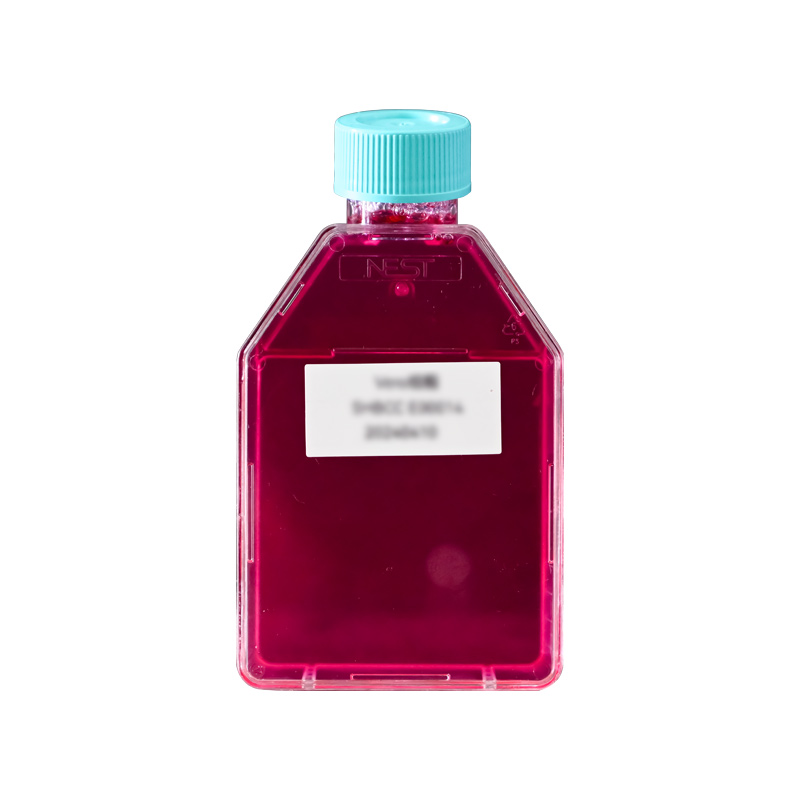人前列腺细胞RWPE-1,RWPE-1,SHMCC E00339返回上一页

人前列腺细胞RWPE-1,RWPE-1,SHMCC E00339
菌株编号:SHMCC E00339
中文名称:人前列腺细胞RWPE-1,RWPE-1,SHMCC E00339
拉丁名称:
价格:¥2000
状态:咨询客服
下载:
产品介绍
平台资源号:
保藏编号:SHMCC E00339
中文名称:人前列腺细胞RWPE-1,RWPE-1,SHMCC E00339
拉丁名称:
模式菌株:
其它保藏中心编号:
来源历史:前列腺
收藏时间:
参考用途:动物种类:人;白人组织来源:前列腺形态:上皮样,贴壁生长性别:男性,54岁细胞描述:一位54岁白人男性的正常前列腺组织切片的周围区域的上皮细胞用单拷贝的人乳头瘤病毒18(HPV-18)进行转化,建立了RWPE-1。据报道,RWPE-1细胞在三维Matrigel培养时,在雄激素刺激下,形成腺胞(acini)并向培养基中分泌PSA。当与Matrigel或基质细胞混合注射雄性裸鼠时,RWPE-1细胞也能形成腺胞并产生PSA。来源于RWPE-1的细胞用Kirsti
生物危害程度:
致病对象:
培养温度:1. 人前列腺细胞RWPE-1培养液配方:Keratinocyte-SFM (Invitrogen, 17005-042) 需氧类型:气相:空气,95%;二氧化碳,5%。 提供方式:T25培养瓶,干冰冻存管(额外+150元) 保存温度:液氮
K-SFM(Invitrogen,17005-042)培养液包含两个组份:基础培养液1瓶(货号10724-011)+生长因子2管(货号37000-015 )。按照K-SFM培养液说明书,需额外添加Gentamicin Solution。建议使用Gentamicin/Amphotericin Solution 500X(Gibco, R-015-10)。
培养条件
1. 人前列腺细胞RWPE-1培养液配方:Keratinocyte-SFM (Invitrogen, 17005-042)
K-SFM(Invitrogen,17005-042)培养液包含两个组份:基础培养液1瓶(货号10724-011)+生长因子2管(货号37000-015 )。按照K-SFM培养液说明书,需额外添加Gentamicin Solution。建议使用Gentamicin/Amphotericin Solution 500X(Gibco, R-015-10)。
注意事项:
a. 细胞在无血清培养体系中培养,其贴壁能力较弱,建议传代后静置24小时再进行后续操作。
b. 细胞密度建议保持在4万~ 7万cells/cm2,接种密度建议在2万~4万活细胞/cm2。
c. 使用0.05%胰酶消化细胞。同时由于K-sfm为无血清培养液无法终止胰酶消化,所以消化完成后要通过添加2%FBS(用D-PBS稀释)或等体积的0.1%大豆胰蛋白酶抑制剂终止消化并离心去除胰酶,再进行后续操作。
参考文献
Webber MM, Rhim JS. Immortalized and malignant human prostatic cell lines. US Patent 5,824,488 dated Oct 20 1998 Bello D, et al. Androgen responsive adult human prostatic epithelial cell lines immortalized by human papillomavirus 18. Carcinogenesis 18: 1215-1223, 1997. PubMed: 9214605 Webber MM, et al. Acinar differentiation by non-malignant immortalized human prostatic epithelial cells and its loss by malignant cells. Carcinogenesis 18: 1225-1231, 1997. PubMed:9214606 Okamoto M, et al. Interleukin-6 and epidermal growth factor promote anchorage-independent growth of immortalized human prostatic epithelial cells treated with N-methyl-N-nitrosourea. Prostate 35: 255-262, 1998. PubMed: 9609548 Webber MM, et al. Immortalized and tumorigenic adult human prostatic epithelial cell lines: characteristics and applications Part 2. Tumorigenic cell lines. Prostate 30: 58-64, 1997. PubMed:9018337 Webber MM, et al. Immortalized and tumorigenic adult human prostatic epithelial cell lines: characteristics and applications. Part 3. Oncogenes, suppressor genes, and applications. Prostate 30: 136-142, 1997. PubMed: 9051152 Kremer R, et al. ras Activation of human prostate epithelial cells induces overexpression of parathyroid hormone-related peptide. Clin. Cancer Res. 3: 855-859, 1997. PubMed: 9815759 Jacob K, et al. Osteonectin promotes prostate cancer cell migration and invasion: a possible mechanism for metastasis to bone. Cancer Res. 59: 4453-4457, 1999. PubMed: 10485497 Achanzar WE, et al. Cadmium induces c-myc, p53, and c-jun expression in normal human prostate epithelial cells as a prelude to apoptosis. Toxicol. Appl. Pharmacol. 164: 291-300, 2000. PubMed: 10799339 Achanzar WE, et al. Cadmium-induced malignant transformation of human prostate epithelial cells. Cancer Res. 61: 455-458, 2001. PubMed: 11212230 Bello-DeOcampo D, et al. Laminin-1 and alpha6beta1 integrin regulate acinar morphogenesis of normal and malignant human prostate epithelial cells. Prostate 46: 142-153, 2001. PubMed:11170142 Webber MM, et al. Human cell lines as an in vitro/in vivo model for prostate carcinogenesis and progression. Prostate 47: 1-13, 2001. PubMed: 11304724 Epithelial cells from a histologically normal adult human prostate were isolated and subsequently transfected with a plasmid carrying one copy of the human papillomavirus 18 (HPV-18) genome to establish the RWPE-1 (ATCC CRL-11609) cell line. Quader ST, et al. Evaluation of the chemopreventive potential of retinoids using a novel in vitro human prostate carcinogenesis model. Mutat. Res. 496: 153-161, 2001. PubMed: 11551491 upregulated upon exposure to androgen Bello D, et al. Androgen responsive adult human prostatic epithelial cell lines immortalized by human papillomavirus 18. Carcinogenesis 18: 1215-1223, 1997. PubMed: 9214605

 021-59199805
021-59199805


 集团咨询服务号
集团咨询服务号




